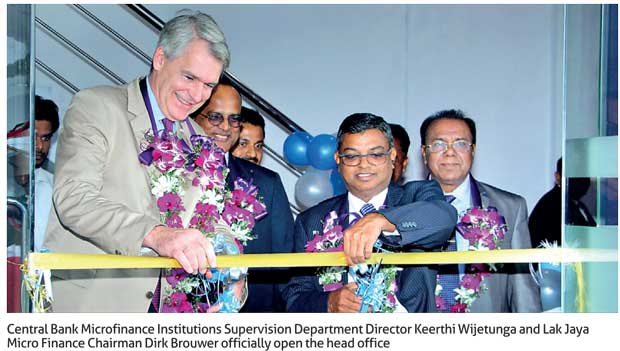04 Dec 2017 - {{hitsCtrl.values.hits}}

Lak Jaya Micro Finance Limited officially opened its head office at No. 386B/1/1, High Level Road, Pannipitiya recently.
The opening ceremony was well-attended with participants from all leading microfinance institutions and some commercial banks.
Central Bank Microfinance Institutions Supervision Department Director Keerthi Wijetunga was the chief guest and the keynote address was delivered by former Samurdhi, Land and Trade Ministries Secretary Dr. R.M.K. Ratnayake.
The company Chairman Dirk Brouwer, members of the board of directors, senior management, long-serving employees and some long-time customers also attended the opening ceremony.
Lak Jaya Micro Finance Limited commenced operations on March 8, 2002 on the basis of group guarantee with the objective of providing credit facilities to the economically active poor, the entrepreneurial poor and vulnerable non-poor who cannot access credit from formal source of finance.
In 2006, it adopted the ASA methodology of microfinance, founded by Md. Shafiqual Haque Choudhury in Bangladesh. ASA methodology of microfinance is based on individual-liability loan system instead of group-liability loan system. The ASA methodology, originated in Bangladesh, has the reputation for its cost-effectiveness and scalability, standardization and transparency, which turns it into one of the most successful models of microfinance in the world.
Catalyst Microfinance Investors (CMI), a leading international investor in microfinance business in the world, invested US $ 1.6 million in Lak Jaya shares through a locally incorporated company called CMI Lanka Holding (Private) Limited. The injection of capital and the adoption of the ASA methodology marked a turning point in evolution of the company and the number of branches increased from six to 46 within little over one year.
Lak Jaya is a microfinance institution with a considerable exposure in the field of microfinance in Sri Lanka. It has come a long way in prospering to its present position. It has successfully outreached to 19 districts with 59 branches operative in remote areas as well as pockets of poverty in urban districts. The company has maintained its operations satisfactorily meeting the demands of the micro and small business sector supporting the female entrepreneurs of the country as evidenced in its steady growth of the loan portfolio and the clientele.
As at present, around 60,000 micro entrepreneurs benefit from the loan programmes of the company and the amount of loans outstanding is around Rs.1.2 billion. The average loan size of Rs.23,000 indicates that the poorer segments of the population are reached. The loans are provided on the basis of trust with simple documentation procedures.
While remaining as a leading microfinance institution in the country, it has maintained a loan recovery rate of around 98 percent throughout the recent years. Its strength lies in the effective supervision of loans that substitutes the requirement for collateral. Its loan operations are conducted through groups of borrowers at field level and these groups are called ‘centres’ and in a centre there are about 20 borrowers who attend weekly centre meetings in their villages to carry out their financial operations.
Lak Jaya has played an important role in creating employment within the company and in the projects it has financed. Presently there are 444 employees in the company of which more than 50 percent are field officers. In addition to the provision of loans, the company is actively promoting financial literacy among its clients and assist them with the necessary advice in carrying out business effectively. Also, it has been active in providing assistance during the times of natural disasters and helping the affected clients to rehabilitate their projects.
Brouwer addressing the gathering highlighted the achievements of the company and the role played by Catalyst Microfinance Investors and ASA International, which is dedicated to promote the ASA methodology in supporting the microfinance sector in the world.
Brouwer emphasized that ASA is recognized as one of the lowest cost, most efficient MIFIs operational in 12 countries and we are very happy to having Lak Jaya as an important member of their family.
While addressing the gathering Wijetunga highlighted the significance of regulation and the types of regulation that would be effected under the Micro Finance Act introduced in 2016. In addition, he emphasized the significance of client protection, responsible finance, deposit insurance schemes and the role of the Credit Information Bureau for minimizing loan risks.
Delivering the keynote address, Dr. Ratnayake analysed the policy towards pro-poor development in Sri Lanka and concluded that the apparent inadequacy of policies of the state to address income inequality led the government to pursue the concept of “pro-poor” growth as an effective measure to reduce the inequality during the process of growth.
The extent to which growth is pro-poor depends on how much a chosen measure of poverty changes as the result of implementing of such policies. The process will lead to better distribution of resources and improving living standards of the poor. ‘Pro-poor’ or ‘inclusive’ growth strategies enable poor people to participate in and benefit from the growth process.
Therefore, he emphasized that adequate policies and programmes are required to reach the poor with capital, if poverty is to be reduced in a meaningful manner. Microcredit initiatives are some credible ways to deliver the most-needed capital to the doorstep of the poor in a speedy manner. In this initiative, the poor families may find credible ways to move out of poverty using their own skills in their own projects using borrowed capital. Thus, what they all needed is capital in the form of small loans, delivered to their doorstep.
25 Nov 2024 8 minute ago
25 Nov 2024 9 minute ago
25 Nov 2024 17 minute ago
25 Nov 2024 17 minute ago
25 Nov 2024 45 minute ago